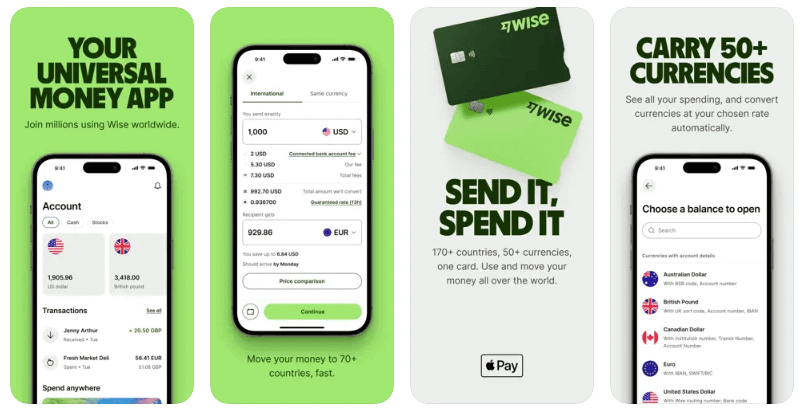Best Multi-Currency Cards: What are the Best Options in Australia? 2025
Spending money in foreign currencies – either when you travel abroad or when you’re shopping online with overseas retailers – can mean extra fees. You might find your bank or card provider uses a foreign transaction fee, or adds an extra charge into the exchange rate used to switch your dollars to the currency you need. In either case, you lose out.
Getting a multi-currency payment card can mean accessing a better exchange rate, and lower overall costs when spending internationally. This guide walks through all you need to know, including the benefits of a multi-currency card, and how multi-currency cards from banks compare against non-bank alternatives like Wise and Revolut.
Our Top 4 Multi-Currency Cards in Australia:
Multi currency cards: the best options in Australia
Let’s start out with an overview of the multi-currency cards we’ll feature here.
You can get a multi-currency card from a bank, a non-bank alternative like Wise and Revolut, or from a currency exchange specialist like Travelex. To help you pick between these options, we’ll cover some of their best features – and there’s more on the pros and cons of each, a little later, too.
| Multi-currency card | Best features |
|---|---|
| Wise card
|
|
| Revolut Card
|
|
| Westpac Travel Money Card
|
|
|
Commbank Travel Money Card
|
|
| Travelex Travel Money Card
|
|
How does the multi currency card work?
Multi-currency cards can be ordered online from banks and specialist non-bank services. In some cases you can also pop in personally to collect or buy a card.
The cards we’ve featured here are linked to either an online account or wallet which can be used to hold and exchange a selection of foreign currencies. You’ll need to top up your card’s balance in AUD or a foreign currency, before spending. When you make a purchase or withdrawal your funds are deducted from the account balance, and you can usually track your spending in an app.
It’s useful to know that different cards work in their own ways, so reading through your options and getting familiar with the features and fees of the cards you’re interested in is essential.
For example, some card providers like Wise and Revolut use mid-market exchange rates, while other banks and card services may add in a markup to the rate used to convert your dollars to the currency you need. The other big difference is usually in how you’ll hold your balance. Some cards require you to switch immediately to a foreign currency to avoid extra charges, while others let you hold a balance in AUD and switch at the point of payment. Both options have their own pros and cons, so weighing up a few is the best way to decide which is the right fit for you.
Best multi currency cards: a comparison
When you choose the right multi-currency card for your needs, the fees will make a big difference. Here’s a side by side comparison of the cards we’ve picked, to help you decide.
| Provider | Annual or order fee | Exchange rate | ATM withdrawal fee |
|---|---|---|---|
| Wise Card | One time 10 AUD order fee
No annual fee |
Mid-market exchange rate | 2 withdrawals up to 350 AUD/month fee free
1.5 AUD + 1.75% after that |
| Revolut Card | Fees depend on the plan you pick:
Standard plan customers have no monthly fee
Premium plan customers pay 9.99 AUD/month
Metal plan customers pay 24.99 AUD/month |
Mid-market exchange rate to plan limit, fair usage fees apply after that
Standard plan customers can convert 2,000 AUD/month with the mid-market rate
Premium plan customers can convert 20,000 AUD/month with the mid-market rate
Metal plan customers can convert an unlimited amount with the mid-market rate |
No ATM fee to plan limit, fair usage fees apply after that
Standard plan customers can withdraw 350 AUD/month with no fee
Premium plan customers can withdraw 700 AUD/month with no fee
Metal plan customers can withdraw 1,400 AUD/month with no fee |
| Westpac Travel Money Card | No annual or card order fee | Westpac rates apply when adding funds in a foreign currency
Mastercard rates apply when spending a currency you don’t hold in your account |
No fee for in network withdrawals
Out of network fees vary by country, 2 AUD in Australia, for example |
| Commbank Travel Money Card | No annual or order fee | Commbank rates apply when adding funds in a foreign currency
Visa rates + a 3% fee apply when spending a currency you don’t hold in your account |
3.5 AUD or the currency equivalent |
| Travelex Travel Money Card | No order fee online – in branch orders may incur a fee if you add funds in AUD
4 AUD inactivity fee if you don’t use your account in 12 months; 10 AUD account closure fee |
Travelex rates apply | No Travelex fee |
Wise card
Open a free multi-currency Wise Account online or in the Wise app, to hold and exchange 40+ currencies with the mid-market exchange rate and low fees from 0.43%. You’ll be able to order your linked international debit card for a low one time fee of 10 AUD, to spend in 150+ countries. Wise accounts can be topped up in around 20 currencies, and also come with local bank details for up to 9 currencies so you can get paid by others conveniently.
Pros of the Wise card
- Broad range of international features with no ongoing card or account charges
- Hold and exchange 40+ currencies with the mid-market rate
- Leave your funds in AUD and let the card convert at the point of payment if you like
Cons of the Wise card
- 10 AUD fee to get your physical card
- Some transaction fees apply

Revolut card
Revolut has 3 different account tiers for personal customers in Australia. You can pick a Standard account which has no monthly fee, or upgrade to an account with a monthly charge to unlock more features and more no-fee transactions. All Revolut accounts come with a linked payment card, and can support 30+ currencies for holding and exchange. Use your card in 150+ countries conveniently for spending and withdrawals – depending on your account tier you’ll get some no-fee ATM withdrawals every month, and some currency conversion which uses the mid-market exchange rate.
Pros of the Revolut card
- Choose the account plan that suits your usage and spending patterns
- Unlock more features, including lounge access and priority support with higher tier accounts
- Get one or more accounts for under 18s, to help younger family members manage their money
Cons of the Revolut card
- Monthly fees apply to get full feature access
- Out of hours fees apply when you exchange funds between 5pm (New York time) on Friday, and 6pm Sunday (New York time)
Read a full Revolut review here

Westpac Travel Money Card
The Westpac travel money card can be ordered online or in a physical branch, and used to hold 11 major world currencies. It’s issued on the Mastercard network and can be used for spending and withdrawals pretty much globally anywhere you see the Mastercard logo.
Pros of the Westpac travel card
- No card issue or account keeping fee
- Lounge access if your flight is delayed by 2 hours or more
- Order your card online or pick up in a Westpac branch for instant access
Cons of the Westpac travel card
- Exchange rates may include a markup
- Out of network ATM fees apply
Read a full Westpac review here
Commbank travel money card
There’s no fee to order your Commbank travel money card, and you can hold 13 currencies for convenient spending and withdrawals overseas. Pick up your card in a branch or online, and add money in the Commbank app or online banking for convenience. You may get access to some purchase protections which can apply if items you buy with your card are lost or stolen within 90 days.
Pros of the Commbank travel card
- No card issue or account keeping fee
- Get instant alerts if your balance in running low, so you can top up
- 13 supported currencies for holding and exchange
Cons of the Commbank travel card
- 3% fee if you spend in a currency you don’t hold in your account
- 3.5 AUD ATM withdrawal fee
Read a full Commbank review here
Travelex Travel Money Card
Travelex has a travel money card you can order online or in a branch, to hold and spend foreign currencies conveniently. It’s free to get your card online or if you’re topping up in a foreign currency, and there are no Travelex ATM fees to worry about. A few fees do apply, which are worth knowing about though – including an inactivity fee and an account closure fee.
Pros of the Travelex travel card
- No Travelex fee for ATM withdrawals and no online card issue fee
- Get free wifi in many locations when you travel
- 10 supported currencies for spending and withdrawals
Cons of the Travelex travel card
- A card closure fee fee may apply, and inactivity fees kick in after 12 months of not using your card
- Exchange rates may include a markup
Read a full Travelex review here.
How can I use a multi currency debit card abroad?
The cards we’ve featured in this guide are issued on the Visa or Mastercard networks – both of which have high global acceptance. To use your card overseas you’ll simply need to look out for the network logo on an ATM or at a payment terminal.
Make sure you know what fees apply to your card before you travel. Sometimes you’ll pay extra when spending in an unsupported currency, for example, or when making an ATM withdrawal. It’s also worth knowing that paying in the local currency wherever you are is the best way to avoid hidden costs. If you’re overseas, and you’re asked at an ATM or by a merchant if you’d prefer to pay in AUD, just say no. That way you’ll get the network or card issuer’s exchange rate, which is usually better than the rate the merchant or ATM will offer.
Read a full guide on the best travel cards for Australians travelling overseas.
How to request a multi currency debit card
You can get a multi-currency debit card online for home delivery – or in some cases, by visiting a bank branch or currency exchange office. Different services have their own processes to get your new card, but generally you’ll need to give your personal and contact details, show some ID to get verified, and add some money to your account to get started.
If you pick an online order option you can complete the whole process from home, including getting verified by uploading an image of your eligible ID document. Your card will then be sent by post – and in some cases you can start to use a virtual card right away.
As an example, here’s how to open a Wise account and order your card, step by step:
- Open the Wise desktop site or app and click on Create account
- Enter your email address, Google, Apple or FaceBook ID
- Tap the type of account you want to open – personal or business
- Follow the prompts to enter your contact information
- Verify your account, following the onscreen instructions
- Once your account is open, tap the Cards tab
- You’ll be able to order your Wise card for home delivery, and get instant access to a Wise virtual card you can use online and with a mobile wallet
What are the transaction fees applied to a multi-currency card?
Different multi-currency cards have their own fees, so checking through the fee schedule for your specific card is important. In many cases it’s free to get your card in the first place, but there are a few other common costs to look out for:
Exchange fee
An exchange fee may be applied for currency conversion, either when you spend or make a withdrawal overseas, or when you top up your account in dollars and switch over to a foreign currency.
Understanding the costs here will help you get the most from your money – pay attention to the exchange rate being used, as well as any stated fees. Some providers use the mid-market exchange rate and split out any conversion costs for transparency but other services apply a markup to the rate used – this is still a charge, but it’s harder to see.
Withdrawal fee
Fees on ATM withdrawals can vary quite a lot, depending on the card you pick. Some card providers charge no overseas ATM fees at all, others have no fees if you use an ATM from a partner network, and some offer a fixed number of fee free ATM withdrawals depending on the card type.
Bear in mind that whichever card you pick, some ATMs also apply their own withdrawal fees. If this is the case you’ll usually see an onscreen message before you confirm your withdrawal – if you do, picking a different ATM could save you money.
Advantages of the foreign currency cards
Having a multi-currency card can be a secure, cheap and convenient way to spend in foreign currencies. Here are a few advantages of multi-currency cards to consider:
- Secure, as cards aren’t linked to your everyday AUD account
- You may benefit from a preferential exchange rate for currency conversion
- Accounts can often be managed via an app for convenience and security
- Make local cash withdrawals wherever you are in the world, to avoid high fees to get your travel spending money
- Easy to budget and manage your international spending
Are there any limitations on the foreign currency card?
Multi-currency cards aren’t perfect through – here are a few limitations it’s worth knowing about:
- Deposits to your account may not be instant, depending on the card and how you choose to top up
- Debit cards aren’t usually accepted whenever a deposit is required – for example to hire a car or when checking into a hotel
- Top up, inactivity and closure fees may apply which push up costs overall
Conclusion: Is the multi-currency card worth it?
A multi-currency card can be handy when you’re transacting internationally, either when you travel in person or if you’re shopping online with overseas retailers. It also means you don’t need to worry about carrying cash when you travel – just use local ATMs on arrival as and when you need them.
Generally, multi-currency cards are easy to get, and come with low overall costs and fair exchange rates. Compare a few cards from banks and non-bank providers, using this handy guide, to help you decide which might suit you best.
FAQs – Best multi-currency cards
What is an international debit card?
International debit cards, which are also commonly called multi-currency debit cards, are payment cards optimised for international transactions. They can make it cheaper – and improve security – when you shop and withdraw cash overseas. Check out services like Wise and Revolut as flexible, low cost travel card options.
How do multi currency cards work?
You can use a multi-currency card in pretty much the same way as you would any other debit card, to make ATM withdrawals and online or in person payments. The main difference is that multi-currency cards are optimised for foreign currency purchases and cash withdrawals.
How to get a multi currency debit card?
You can get a multi-currency debit card from a bank or for an online specialist provider. All the options we’ve covered here let you order online, to get an account and card without needing to leave home.
How to use my debit card abroad?
Use your card abroad just as you would here at home. Multi-currency debit cards from providers like Wise and Revolut are really only different in that they usually have features which make it cheaper and more convenient to spend internationally, whether you’re shopping online, hitting the stores in person or making an ATM withdrawal.
What are the fees for a multi currency debit card?
Multi-currency debit card fees do vary between providers and can include currency conversion or foreign transaction fees, and charges to make ATM withdrawals. Sometimes, inactivity and account closure fees also apply. Use this guide to pick the right one for you, and remember to compare bank multi-currency cards against other non-bank options like Wise and Revolut.




